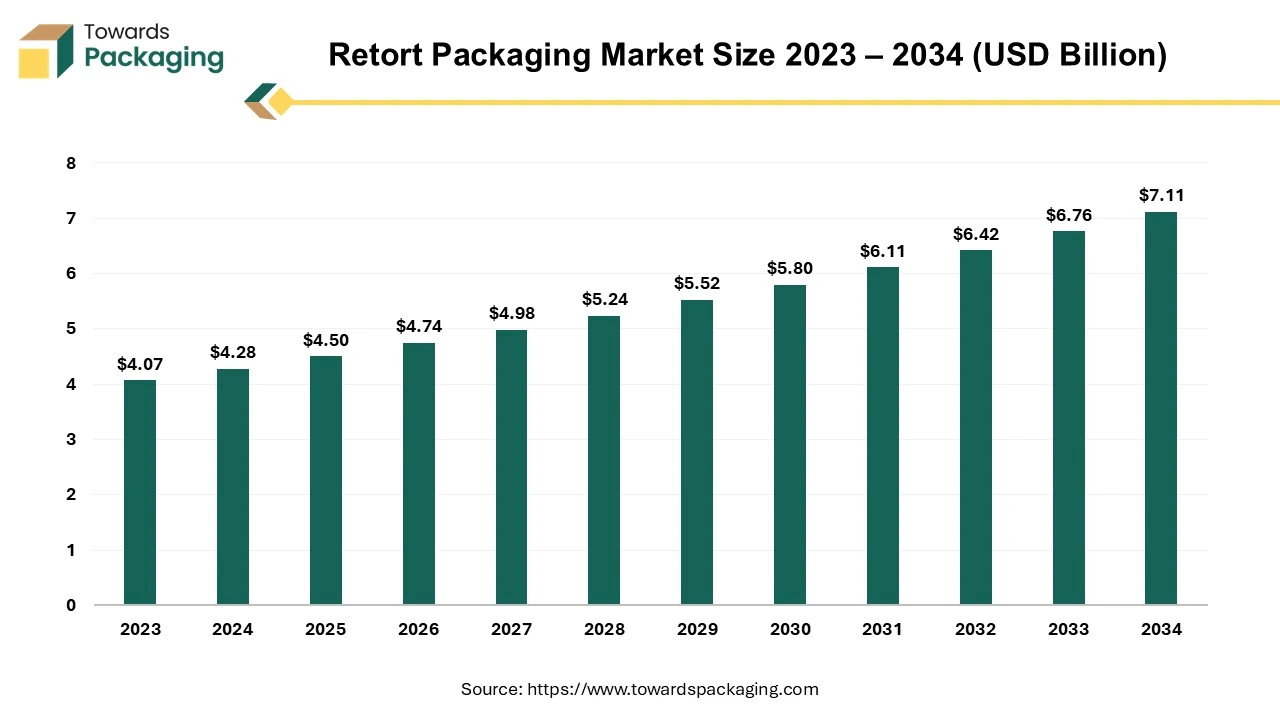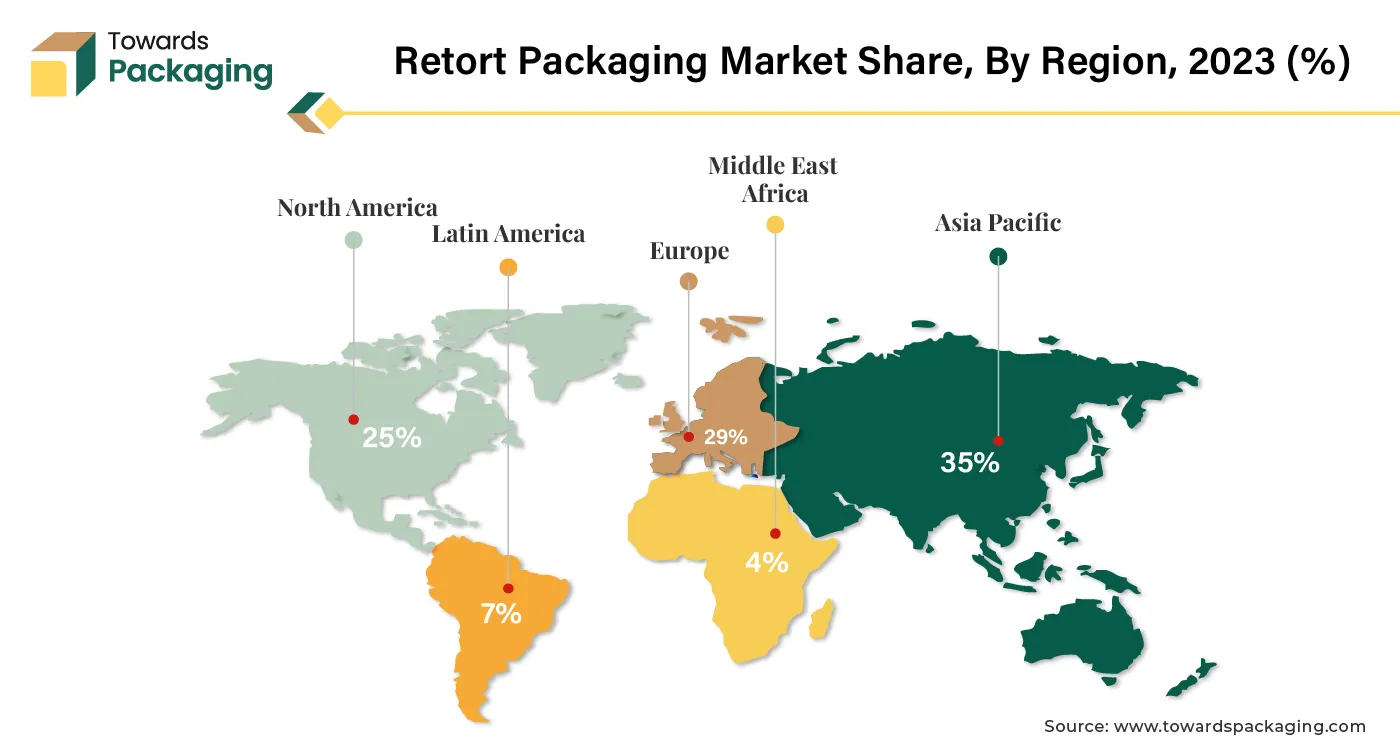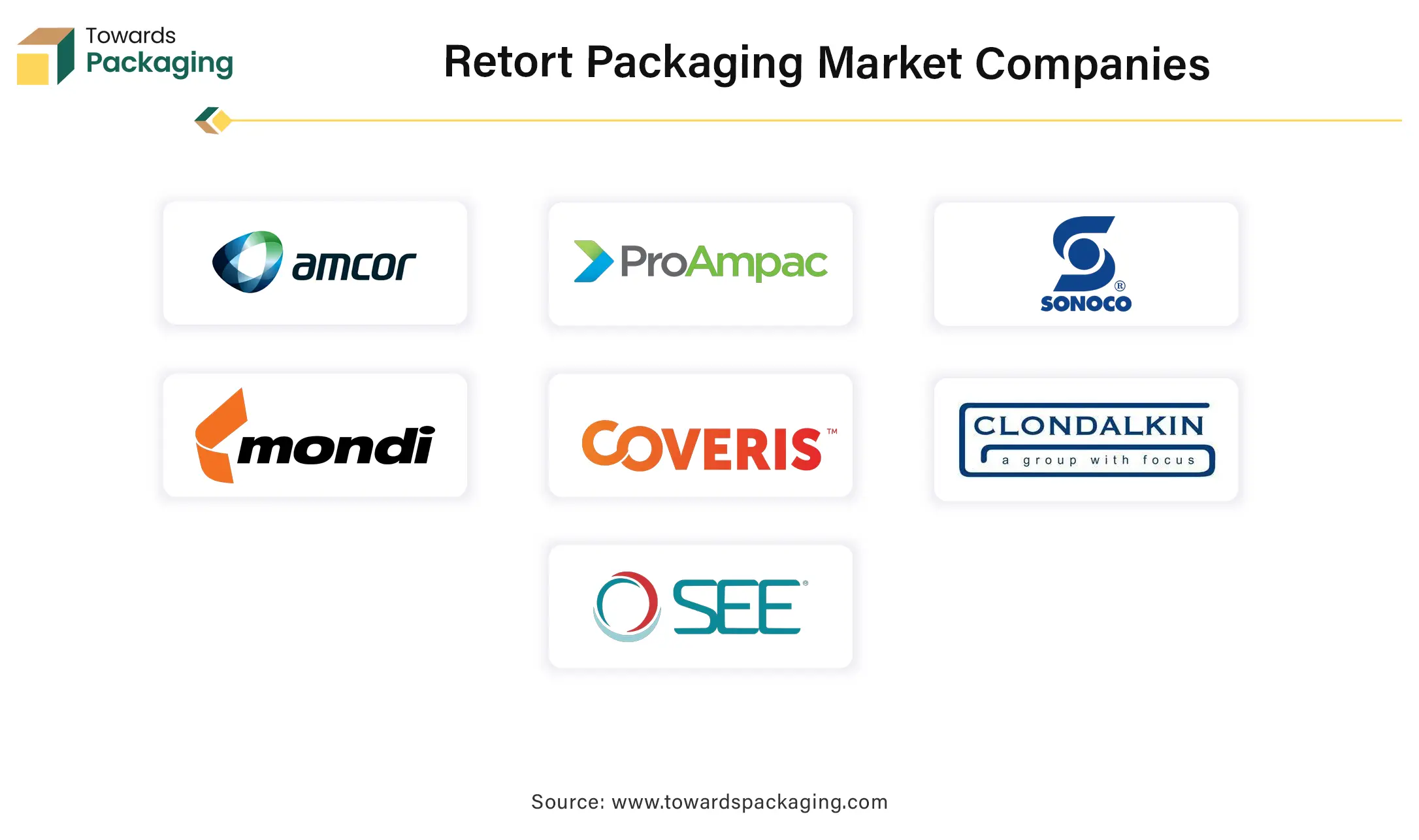April 2025
The global retort packaging market size was evaluated at US$ 4.07 billion in 2023 and is expected to attain around US$ 7.11 billion by 2034, growing at a CAGR of 5.2% from 2024 to 2034.

Retort packaging material is a sterilizable packaging material, constructed with thin and bonded layers that can withstand processing a product inside at 120°C. Retort pouches are a relatively new variety of food packing container that weighs less than glass jars or metal cans. Before serving, the contents can be rapidly reheated in about three minutes by heating the entire bag in a microwave or by immersing it in boiling water. As a novel method and material for food preservation, the pouch has been gaining traction alongside glass jars, metal cans, and other plastic materials.
That a product in a retort pouch is cooked inside the sealed bag may surprise a lot of customers. Retorting, which is the same as autoclaving, is a novel method of packaging that involves heating and sterilising the container and its contents. In the food and non-food manufacturing sectors, the process of heat-treating items in their packaging is used to either commercially sterilise equipment, packaging, and parts, or to complete cooking the product for an extended shelf life. The product to be heated is placed within the retort pouch, which is then hermetically sealed, such as airtight and heated following industry standards for both duration and temperature.
Retort pouches and bags make up 60% of all food packaging globally. The invention of heat-resistant plastic film and non-toxic adhesive substances hastened the retort pouch movement. Recognising the enormous potential of using plastic bags to package food for battle rations, the US Army, through its Natic Development Centre, initiated a programme to make use of this novel approach. The Centre accomplished a lot of noteworthy things. The Centre tested the retort pouch's seal integrity, sterilisation properties, and percentage of defects in the container food production. The results showed that the retort pouch was just as reliable as metal cans in demonstrating its suitability as a safe food preservation tool. The global market is expected to reach at 4.50 U$D Billion by 2025.
Retort pouch foodstuff is now made in numerous more nations in addition to these. Retort foods are packaged in trays and cups instead of pouches in the US and Europe. Food in retort pouches is becoming more and more popular in Asian markets, including Korea and Taiwan.
The rapid rise of online food ordering has a notable impact on the food and beverage industry. This rise has helped the growth of retort packaging market too. The number of consumers opting for online delivery leads to growing demand for packaging that is easy to handle and convenient for customers as well as delivery persons. With retort packaging, the shelf life of the food products is extended which is key factor for online delivery.
The products with this packaging are able to be stored for a longer duration without the need for refrigeration. This helps maintain the quality of the food products and reduce chances of food wastage. The retort packaging makes it easier for the food products to be transported, cooked, and reheated. This makes them a popular choice for the for packaging of meals or snacks that are quick and easy-to-eat. These factors provide ample opportunity for the retort packaging to grow along with rising demand for online food delivery services.
|
Shift in consumer preferences:
Recycle ready retort packaging:
|
Brand recognition through packaging:
Economic and demographic growth:
|
Artificial Intelligence (AI) is poised to transform the retort packaging market by enhancing efficiency, quality, and innovation. With AI-driven analytics and machine learning, manufacturers can optimize the design and production processes of retort packaging, leading to improved product safety and extended shelf life. AI algorithms analyze vast amounts of data to predict and prevent potential defects, ensuring higher-quality packaging that meets rigorous standards.
AI also enables real-time monitoring and quality control, allowing for immediate adjustments during production. This reduces waste and minimizes the risk of costly recalls. Predictive maintenance powered by AI helps in identifying equipment issues before they lead to failures, thus improving operational efficiency and reducing downtime.
Moreover, AI facilitates the development of innovative packaging solutions by analyzing consumer trends and preferences. This insight enables companies to design packaging that caters to evolving market demands and enhances user experience. Overall, AI integration in the retort packaging market not only streamlines operations but also drives innovation, positioning companies for sustainable growth in a competitive landscape.

One of the markets' fastest-growing regions is Asia Pacific. Retort pouch demand is predicted to be particularly high in the Asia-Pacific region due to the growing need for more convenient food and beverage packaging options. Furthermore, a sizable demand for retort pouch packaging has been generated by China's quick economic growth and rising standard of living.
The transformative forces driving the adoption of retort pouches in the Asia-Pacific region are multifaceted. Urbanization, notable lifestyle shifts, and a concurrent rise in annual disposable income collectively propel the demand for processed foods. This, in turn, catalyses the increased utilization of retort pouch packaging. The rise of convenient, ready-to-eat meals aligns with the fast-paced lifestyles prevalent in urban centres, further amplifying the demand for these versatile packaging solutions.
India, another economic powerhouse in the region, has witnessed a surge in sustainable packaging practices. The uptick in the consumption of packaged foods, coupled with heightened consumer awareness regarding environmental impact, has fuelled the demand for eco-friendly packaging solutions, including retort pouches. The Packaging Industry Association of India (PIAI) reports an annual growth rate of 22 to 25 per cent, emphasizing the significant strides made by the packaging sector. Notably, the food processing industry, a major player in India's economic landscape, accounted for 32 per cent of the nation's total food market, ranking fifth in terms of production, consumption, exports, and anticipated growth.
Retort pouches and other flexible packaging solutions are expected to be in high demand in South Korea, particularly from the FMCG (fast-moving consumer goods) industry. Retort pouches combine the benefits of lightweight, convenient packaging with the changing preferences of consumers. These pouches are positioned for quick acceptance because of their adaptability in meeting the changing needs of the food and beverage industry. As a result, the packaging business in South Korea stands to benefit from the growing demand for retort pouches, which will encourage innovation and expansion.
The demand for retort pouches is astoundingly rising throughout the Asia-Pacific region, led by economic giants like China and India. The food and beverage industry's adoption of retort pouches is transforming the packaging environment due to factors like urbanisation, changing lifestyles, and a growing middle class with more discretionary income. Retort pouches' adaptability and sustainability allow them to remain a key component of the competitive and dynamic packaging market in the Asia-Pacific region, even as the sector continues to evolve.
For Instance,
Retort Pouch Food was still used for domestic purposes, despite an increasing trend towards commercial use for use in commerce. Pouch for Retort Food keeps gaining traction with Asia-pacific customers because of the abundance of goods, ease of use, and decreased quantity of extended shelf life and kitchen waste. Japan evolved and developed retort food packaging.

One of Japan's earliest commercially released products was a retort curry. At the period, Japan's fast economic expansion was changing people's everyday lives and increasing demand for quick and simple meals. The single-serving curry, in response, just required reheating the pouch in hot water. Dipping sauces, Seasoning sauces, Pasta sauces and soups were among the many other cuisines that gained popularity because of this curry. Additionally, Japanese tofu, meat fisheries and other agricultural products caught a quite attraction in Japan for retort pouches food products.
For Instance,
In the ever-evolving landscape of the food industry, one innovation stands out as a game-changer: retort packaging. This cutting-edge packaging solution has become a cornerstone in the sector, catering to a spectrum of products ranging from ready-to-eat meals and meats to sauces, baby food, and frozen delicacies. Its impact on the market is nothing short of transformative, combining enhanced flexibility and robust protection against pathogens, thereby propelling its widespread adoption.
The United States Department of Agriculture (USDA) recommends retort packing, which is a popular option because of its adaptability and usefulness. Because of its streamlined shape, the flat, space-saving pouch not only makes storing in pockets or bags easier but also provides processing with operational benefits.
Retort packaging is used for many different types of food products. When it comes to preserving the freshness of seafood like prawns, tuna, salmon, and mackerel as well as meats like beef, chicken and pig, retort pouches are the go-to option. Furthermore, the packaging expands its reach to encompass a variety of food products such as sauces, grains, pasta meals, organic products, fruits, vegetables, and baby food variations. This thorough examination establishes retort packing as a cornerstone of modern food preservation.
Two factors are driving the food industry's adoption of retort packaging: protection and flexibility. The adaptability of the packaging satisfies the changing needs of contemporary consumer lifestyles, where convenience is of the utmost importance. It also guarantees the safety and durability of the packaged goods due to its strong defence against infections. This mutually beneficial link between protection and flexibility drives the market for retort packaging's constant growth. Retort packaging is a shining example of advancement in the ever-evolving global food sector. Food preservation is anticipated to change in the future due to innovations in this field that are motivated by a dedication to sustainability and environmental friendliness. Retort packaging is evolving on a trajectory of constant improvement, from the use of biodegradable materials to the integration of smart packaging technologies, suggesting a future where the freshness of culinary creations is balanced with an environmental conscience.
For Instance,
For Instance,
In the ever-evolving landscape of the global packaging industry, technological advancements play a pivotal role in shaping the trajectory of growth, with retort packaging emerging as a prime beneficiary of innovative solutions. These technological applications not only enhance the efficiency and functionality of retort packaging but also contribute significantly to its widespread adoption, fostering a conducive environment for market expansion.
One of the noteworthy technological applications in retort packaging is the integration of modified atmosphere packaging (MAP) technology. MAP involves altering the gaseous composition within the packaging to extend the shelf life of the contents. This technology mitigates oxidation, moisture, and microbial activity, preserving the freshness and quality of the packaged food. The controlled atmosphere created by MAP technology enhances the overall safety and longevity of the products, aligning perfectly with consumer expectations for convenient and long-lasting ready-to-eat meals.
Additionally, advancements in barrier materials have proven instrumental in enhancing the protective properties of retort packaging. The utilization of high-performance films and laminates acts as a barrier against external elements such as light, oxygen, and moisture. This not only safeguards the integrity of the packaged products but also ensures that they remain visually appealing and palatable to consumers. Government agencies, such as the European Food Safety Authority (EFSA), and U.S. Food and Drug Administration (FDA) play a critical role in regulating and approving the use of these innovative materials, ensuring that they meet stringent safety standards.
Smart packaging technologies have also found their way into the realm of retort packaging, contributing to its market growth. Incorporating features like smart packaging QR codes, RFID (Radio-Frequency Identification) tags, and sensors provides real-time information about the product's condition and history. This not only enhances traceability and quality control but also addresses consumer concerns regarding transparency and authenticity. Government initiatives focusing on food safety and traceability further underscore the importance of these technologies in the retort packaging sector.
Moreover, the advent of nanotechnology has opened new frontiers in the development of advanced packaging solutions. Nanocomposites, with their enhanced mechanical, barrier, and antimicrobial properties, have been integrated into retort packaging materials. These nanomaterials contribute to improved durability and protection, further extending the shelf life of packaged products. Regulatory bodies such as the U.S. Environmental Protection Agency (EPA) and the European Chemicals Agency (ECHA) closely monitor the safety and environmental impact of nanomaterials, ensuring responsible innovation in the packaging industry.
The global push toward sustainability has spurred the development of eco-friendly materials in retort packaging. Biodegradable and compostable packaging materials are gaining prominence, aligning with the environmental goals set by various governments. Regulatory frameworks, such as the European Union's Circular Economy Action Plan, encourage the adoption of sustainable packaging practices, driving the market toward greener alternatives.
The technological applications in retort packaging are instrumental in propelling its global growth. From modified atmosphere packaging to smart packaging technologies and nanocomposites, these innovations address key challenges in the industry while aligning with regulatory standards set by government authorities. As the market continues to evolve, the synergy between technological advancements and regulatory frameworks will remain crucial, shaping the future of retort packaging as a cornerstone in the global food packaging industry.
The supply chain in the retort packaging market involves a complex network of processes designed to ensure efficient production and delivery of packaging solutions. It begins with raw material procurement, where suppliers provide essential materials such as aluminum, plastic, and laminated films. These materials are then transported to manufacturing facilities, where they are processed into retort pouches or cans.
At the manufacturing stage, advanced technologies are employed to create high-quality, durable packaging that can withstand high temperatures and pressures during sterilization. Once produced, the packaging materials are shipped to food and beverage companies, pharmaceutical manufacturers, and other end-users. These clients utilize the retort packaging for preserving and extending the shelf life of their products.
Logistics play a crucial role in this supply chain, ensuring timely delivery of packaging materials and finished products. Distribution networks are optimized to reduce lead times and minimize costs. Additionally, effective inventory management and coordination between suppliers, manufacturers, and end-users are vital to prevent disruptions and maintain a steady flow of goods.
Overall, the retort packaging supply chain is a dynamic system requiring precise coordination and efficient logistics to meet market demands and ensure product quality.
For Instance,
The market for retort pouch packaging is characterised by intense competition because there are several key players such as Amcor plc, ProAmpac, Sonoco Products Company, Mondi, Coveris, CLONDALKIN GROUP, Sealed Air, and others. This market has a medium level of market concentration, and several major players are present, using tactics such as product innovation, acquisitions, mergers and to obtain a competitive edge.
Bimbosan and flexible packaging manufacturer ProAmpac collaborated to create the ProActive renewable pouch for the infant food industry in August 2020. The sealing layer of this new pouch contains 65% bio-based glue, which can lessen its carbon footprint on the environment. Coveris Holdings inaugurated its new Pack Innovation Centre in Halle, Germany, in July 2020. Positioned as a European hub for technical product development, sustainable innovation, and education, the centre helps clients innovate, educate and validate the flexible packaging of the future.

By Material
By End Use
By Region
April 2025
April 2025
April 2025
April 2025